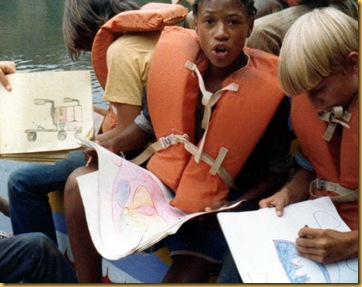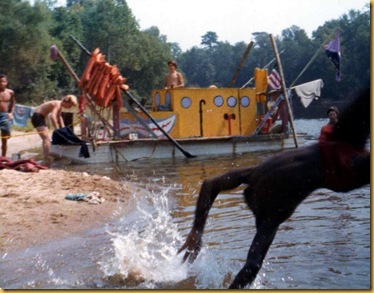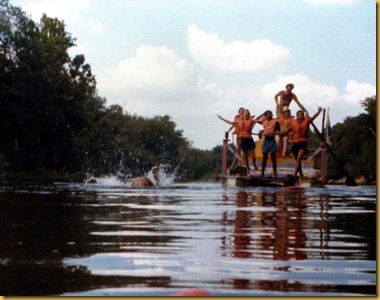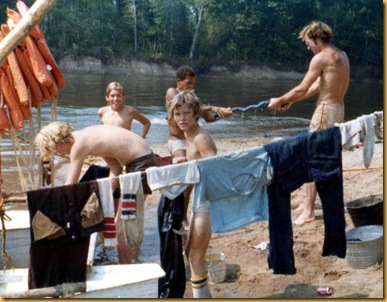Sandbars ruled the route of the raft down the Savannah River. They directed the way around a bend. They were hazards to avoid lest the raft run aground. They provided a diving board for campers during a lunch stop. And they accorded soft rest for ten campers, Chief Bob, and me while all of us slept in tents pitched on them.
Pontoons technically kept the craft from being one, but the ten boys of Chimpta Group from Camp E-ku-Summee on the Uwharrie National Forest near Candor, North Carolina insisted on calling it the “Yellow Submarine,” and painted it a bright yellow with a toothy, impudent smile on its front. I suppose their giddy excitement at the prospect of floating for twenty eight days on it down the border between South Carolina and Georgia is what suspended more careful christening.
Why not paddle canoes, the usual therapeutic maneuver marshaled by the managers of the Eckerd wilderness camping program? Well, “it’s in the field manual” to use the words of Tom Hank’s character in Saving Private Ryan.
That manual would be the bible, of sorts, called Wilderness Road, published in 1965 by Campbell Loughmiller of the Dallas, Texas Salesmanship Club. Director of Camp Woodland Springs, the Club’s primary beneficiary, he had tinkered for twenty years by then with using camping as the tool toward rehabilitating kids with emotional problems. There’s a chapter about rafting down the Red River and then down the Mississippi to New Orleans. I looked it up recently.
From an academic point of view, perhaps the most pertinent undertaking for the trip was an intensive study of the Savannah River watershed. Map study and social studies provided the main focus. Putting in had to be below the “fall line” off the Piedmont Plateau before which much of the river had been stopped by dams. Serving then as one long spill way, the route from there to the city from which it derives its name was narrow, yet deep enough for big boats, including tugs pushing barges. We marveled one time in camp inspecting how the river captain of one such tug nimbly finessed its lumbering push toy around the narrow bend on which our campsite lay.

Using no power, just floating like Huck Finn’s, Yellow Submarine had no use for a rudder. So one of the academic questions in the preparation was how a sweep oar would be used for steering. Then there were measurement exercises of all kinds, from coinciding cabinet dimensions with equipment volumes, and loading weight with pontoon buoyancy specifications. I remember dissuading the menu crew from an inordinate reliance on breakfasts consisting of hominy grits with Cheese Whiz stirred in. Though never described using the term, “school” continued on board with lessons in art, botany, reading, and journal writing.
The boys had to calibrate river speed with channel length in order to gauge where to put in and take out according to allotted time of travel. The Savannah River turned out to be a rather fast-flowing stream. I proved that one day when swimming free, no PFD, so I could scull down to the river bottom. The river bottom whipped along handily underneath my feet. We easily reached the city of Savannah with time for layovers, I remember.
If one word summarized the feel of the trip, that word is gritty. Sand got into everything. Campsite cleaning became grit removal mostly. And if one paragraph summarized the meaning of the trip, that paragraph is found in Campbell’s book in the chapter RAFT TRIPS.
“If the raft belonged to the boys when they weighed anchor at Denison, Texas, it belonged to them now in a deeper sense. It had acquired a spiritual quality. It had been so intimately and vitally a part of their lives for these many weeks that they had regarded it almost with affection.”




No comments:
Post a Comment